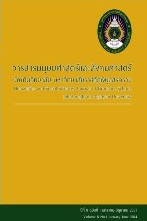ปัจจัยที่มีอิทธิพลต่อผลสัมฤทธิ์ทางการเรียนกลุ่มสาระการเรียนรู้วิทยาศาสตร์ของนักเรียนชั้นประถมศึกษาปีที่ 6 ในโรงเรียนสังกัดสำนักงานเขตพื้นที่การศึกษาประถมศึกษาจังหวัดพิษณุโลก: การวิเคราะห์พหุระดับ โดยใช้โมเดลระดับลดหลั่นเชิงเส้น (HLM)
Keywords:
ปัจจัยที่มีอิทธิพลต่อผลสัมฤทธิ์ทางการเรียนกลุ่มสาระการเรียนรู้วิทยาศาสตร์, การวิเคราะห์พหุระดับโดยใช้โมเดลระดับลดหลั่นเชิงเส้น (HLM), The factors affecting science, Achievement a multilevel analysis using hierarchical linear model (HLM)Abstract
การวิจัยในครั้งนี้มีจุดมุ่งหมายเพื่อศึกษาตัวแปรที่มีอิทธิพลต่อผลสัมฤทธิ์ทางการเรียนกลุ่มสาระการเรียนรู้สาระวิทยาศาสตร์ของนักเรียนชั้นประถมศึกษาปีที่ 6 ในโรงเรียนสังกัดสำนักงานเขตพื้นที่การศึกษาประถมศึกษาพิษณุโลกกลุ่มตัวอย่างที่ใช้ได้แก่นักเรียนชั้นประถมศึกษาปีที่ 6 ภาคเรียนที่ 2 ปีการศึกษา 2554 จำนวน 2,398 คนได้มาโดยการสุ่มแบบหลายขั้นตอน (Multi-stage random sampling) โดยศึกษาตัวแปรระดับนักเรียน 5 ตัวแปรได้แก่เจตคติต่อการเรียนสาระวิทยาศาสตร์แรงจูงใจใฝ่สัมฤทธิ์ทางวิทยาศาสตร์ความสัมพันธ์ภายในครอบครัวการส่งเสริมการเรียนของผู้ปกครองและเวลาที่ใช้ในการศึกษาเพิ่มเติมตัวแปรระดับห้องเรียน 3 ตัวแปรได้แก่คุณภาพการสอนของครูพฤติกรรมการสอนสาระวิทยาศาสตร์และบรรยากาศในชั้นเรียนตัวแปรตามได้แก่ผลสัมฤทธิ์ทางการเรียนสาระวิทยาศาสตร์เครื่องมือที่ใช้ประกอบด้วยแบบสอบถามวัดเจตคติต่อการเรียนสาระวิทยาศาสตร์แบบสอบถามวัดแรงจูงใจใฝ่สัมฤทธิ์ทางวิทยาศาสตร์แบบสอบถามความสัมพันธ์ภายในครอบครัวแบบสอบถามการส่งเสริมการเรียนของผู้ปกครองแบบสอบถามเวลาที่ใช้ในการศึกษาเพิ่มเติมแบบสอบถามคุณภาพการสอนของครูแบบสอบถามพฤติกรรมการสอนสาระวิทยาศาสตร์แบบสอบถามบรรยากาศในชั้นเรียนและคะแนนจากผลการสอบวัดผลสัมฤทธิ์ทางการเรียนระดับชาติ
กลุ่มสาระการเรียนรู้วิทยาศาสตร์วิเคราะห์ข้อมูลโดยการวิเคราะห์พหุระดับ (Multi –level analysis) โดยใช้โปแกรม HLM ผลการวิเคราะห์ที่สำคัญปรากฏดังนี้
1. ตัวแปรอิสระระดับนักเรียนที่มีอิทธิพลต่อค่าเฉลี่ยกลุ่มสาระการเรียนรู้วิทยาศาสตร์อย่างมีนัยสำคัญทางสถิติที่ระดับ .01 ได้แก่เจตคติต่อการเรียนกลุ่มสาระการเรียนรู้วิทยาศาสตร์มีค่าสัมประสิทธิ์การถดถอยเท่ากับ 10.603 การส่งเสริมการเรียนของผู้ปกครองมีค่าสัมประสิทธิ์การถดถอยเท่ากับ 2.17 และเวลาที่ใช้ในการศึกษาเพิ่มเติมมีค่าสัมประสิทธิ์การถดถอยเท่ากับ 5.613
2. ตัวแปรระดับห้องเรียนที่มีอิทธิพลต่อผลสัมฤทธิ์ทางการเรียนกลุ่มสาระการเรียนรู้วิทยาศาสตร์คือบรรยากาศในชั้นเรียนโดยมีค่าสัมประสิทธิ์การถดถอยเท่ากับ 2.286 รองลงมาคือพฤติกรรมการสอนกลุ่มสาระการเรียนรู้วิทยาศาสตร์โดยมีค่าสัมประสิทธิ์การถดถอยเท่ากับ 1.829 ซึ่งไม่มีนัยสำคัญทางสถิติ
3. ตัวแปรอิสระระดับห้องเรียนที่มีอิทธิพลต่อค่าสัมประสิทธิ์การถดถอยของเวลาที่ใช้ในการศึกษาเพิ่มเติมที่ส่งผลต่อผลสัมฤทธิ์ทางการเรียนกลุ่มสาระการเรียนรู้วิทยาศาสตร์ (Slope ของ Time : b5j) คือคุณภาพการสอนของครูโดยมีค่าเท่ากับ 12.72 มีนัยสำคัญทางสถิติที่ระดับ .05
4. ได้สมการพหุระดับแสดงอิทธิพลของตัวแปรสองระดับที่มีต่อผลสัมฤทธิ์ทางการเรียนรู้กลุ่มสาระวิทยาศาสตร์ในรูปแบบคะแนนมาตรฐานได้ดังนี้
โมเดลระดับนักเรียน (Within – student-level Model)
Yij = boj + 10.603 (ATT**) + 1.592 (MOT) + 0.678 (RELA) +2.17
(PLS*) + 5.613 (TIME**) + e1j
โมเดลระดับห้องเรียน (Between-Class Model)
boj = 0.236 (QUA) + 1.829 (TEAC) + 2.286 (CLA) + uo
Time Slope (b5j) = 12.721 (QUA*) + 9.925 (TEAC) + 4.615 (CLA) + U5
ทั้งนี้ตัวแปรอิสระทั้ง 2 ระดับสามารถร่วมกันอธิบายความแปรปรวนของค่าเฉลี่ยผลสัมฤทธิ์ทางการเรียนกลุ่มสาระการเรียนรู้วิทยาศาสตร์ได้ร้อยละ 22.13
An affecting which influence science achievement of prathomsuksa 6 students in school of Phitsanulok Educational Service Area Office: An analysis of multi-level by using hierarchical linear model (HLM)
The purpose of this research were to study the variables that influence science achievement of prathomsuksa 6 students in schools of phitsanulok educational service area office in the 2544 academic year. The samples consisted of 2,398 students in second term of prathomsuksa 6 by using multi-stage random sampling. The independent variables of students–level were scientific attitude, science achievement motivation, family relationships, parent,s learning support and time on task. The dependent variables of class-level were instructional quality, teaching behavior and class environment. The dependent variable was science achievement. Research instruments included the science achievement scale, a questionnaire on scientific attitude, a questionnaire on the science achievement.
Motivation, a questionnaire on the parent,s learning support, a questionnaire on the time on task, a questionnaire on the instructional quality, a questionnaire on the teaching behavior, a questionnaire on the class environment and the score from national test of science. The data were system apically analyzed by Multi-level analysis with HLM edition for windows.
Results were as follow:
1. The student-level variables which mean influenced science achievement level of significance 0.1 were the scientific attitude with simple correlation coefficient of 10.603, the motivation of their parents with simple correlation coefficient of 2.17 and the time on task with simple correlation coefficient of 5.613.
2. The class–level of the variables which influenced science achievement were the class environment with simple correlation coefficient of 2.286, then the Instructional behavior with simple correlation coefficient of 1.829, with its non-significant.
3. The class-level of the variables which influence science achievement to the time on task with simple correlation coefficient of the instructional quality with it level significant of .05.
4. The variables in the model were found mean science a achievement on the Z-score was show below.
student level :
Yij = boj + 10.603 (ATT**) + 1.592 (MOT) + 0.678 (RELA) + 2.17
(PLS*) + 5.613 (TIME**)+ e1j
classroom level :
boj = 0.236 (QUA) + 1.829 (TEAC) + 2.286 (CLA) + uo
time slope (b5j) = 12.721 (QUA*) + 9.925 (TEAC) + 4.615 (CLA) + U5
Both of these variables can explain the variables of science achievement
With 22.13 percent.
Downloads
How to Cite
Issue
Section
License
Any articles or comments appearing in the Journal of Humanities and Social Sciences, Rajabhat Phibulsongkram University, are the intellectual property of the authors, and do not necessarily reflect the views of the editorial board. Published articles are copyrighted by the Journal of Humanities and Social Sciences, Rajabhat Phibulsongkram University.









